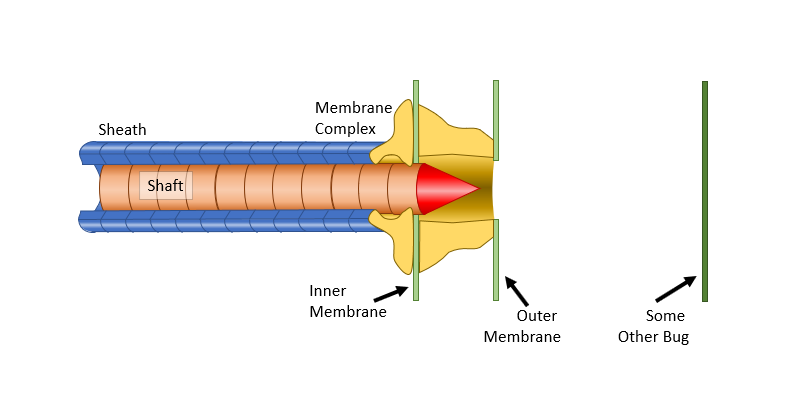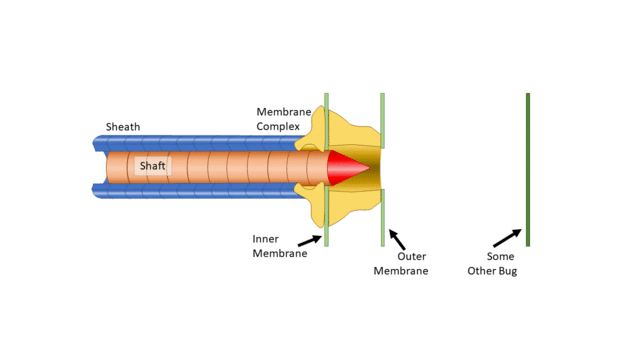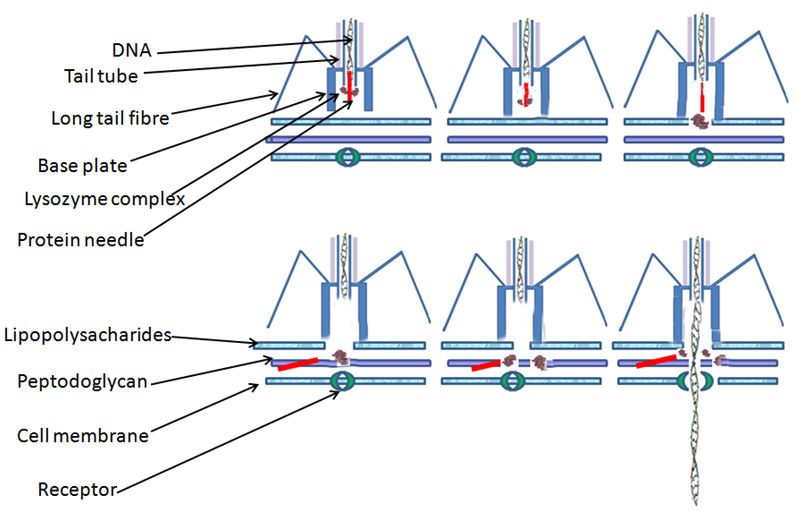What's cool? Bacteria tossing spears at each other. That's cool.
Engineering microbial ecosystems is the bread and butter of my field and, by its nature, this means having to think about bacterial competition. To an environmental engineer, this translates to 'how well can the bugs I want grab energy and grow, relative to other bugs in the system'? Although we know that ignoring things like microbial antagonism is a simplification, many useful models have resulted from it. By just accounting for growth rates, we can predict methane production in anaerobic digesters and determine how well our wastewater treatment plants remove carbon, nitrogen, and phosphate.
However, this means we miss out on a lot of cool stuff and that is a damned shame. I've already written about some of these systems, like my recentish article on 'killer' paramecia and my first non #introduceyourself post here on bacteria-on-bacteria predation, but there are tons of other systems out there. When I learned about today's topic, I wanted to run around my department shouting, "Did you hear about this? It is too freaking cool! Why are we not talking about this all the time?!" The formal name is kind of dry type VI secretion systems, which is why I prefer the popular term - bacterial spearguns (aka bacterial harpoons or bacterial nano-spears). Before I get any deeper I want to assure you that this isn't some weird analogy, it's exactly what you think it is: bacteria swarming around, literally firing off little warhead-tipped spears at each other!

So, what is a type VI secretion system?
Depending on how you want to break it down, a Type VI secretion system (T6SS) is composed of a handful of proteins. In my cartoon, I've simplified it a little by combining a few things into functional units. First, there's set of proteins linked up in a line forming the spear shaft. On top of the shaft is a complex of proteins, which I've drawn as a red cone, whose major purposes are to penetrate other cells and deliver a deadly custom payload. In the relaxed state, the shaft and tip sit inside a stack of donuts, which act as a sheath. When the proteins in the sheath are activated, they propel the spear out and into the victim. The responsibilities of the yellowish baseplate and transmembrane proteins are holding all of this in place and providing an exit for the spear. Once the spear penetrates the victim, a signalling protein (not pictured) causes the tip to break off, releasing a payload of various toxins. At the same time, the spear and sheath themselves breakdown into their component proteins (Can you guess why? I'll tell you in a bit).
That's a lot of words. Let's take a look at it in action.

Antagonism and kin recognition
Unlike the sometimes subtle competition we see in things like 'high substrate affinity' vs 'high growth rate' bugs, this mode of antagonism is straightforward, brutish, and awesome. I'm fairly confident most of you understand how going around and poking holes in your neighbors, then filling them with toxins could help you survive as a bug. But what if I asked you about friendly fire?
See, the thing about bugs is that although we tend to think of them as single cells, they really shine when there's a lot of them and their close kin working together. This is fairly true for most organisms, but it's really, really important in bacterial competition. Based on that, you're probably guessing the bugs have some friend-or-foe recognition system (kin recognition) and only fire off their spears selectively. If you are, congratulations, you're wrong. The bugs that do T6SS stuff generally just wander around, firing out spears indiscriminately at anything that gets close enough, even if it's the cell they just split from. In fact, some bugs, like certain strains of Vibrio cholerae, continually express T6SS proteins, they're never not stabbing things!
If that were the whole story, this would be a terrible long term strategy. Fortunately for our stabby little friends, they do have a form of kin recognition. The key is that while getting stabbed is no fun, it's not actually enough to seriously hurt the bug and cause it to breakdown (lysis). The real killers are those custom toxins I wrote about earlier. Essentially, close kin using T6SS all have spent some time developing an immunity to their particular toxin and express the antidote for it, even in individuals not actively making the speargun. You can call this the Dread Pirate Roberts iocane method of kin-recognition, if you wish.
Waste not, want not
At this point, you may be thinking that, sure, that kind of kin recognition may work, but it's kind of wasteful to be building all these spears and flinging them at your closest clones. This is where that spear & sheath breakdown process comes into play. Although some bugs, like the Vibrio strains I mentioned earlier are hardcore and always throwing spears, many others only selectively make the spears when they have to. Remember, all of that protein takes energy, and if it's not helping your crush your enemies, it's just keeping you from making more copies of yourself, which is kind of the meaning of life. So, here's the really cool part - it allows bugs who can afford to make spears to help out their kin who can't. What happens is that related bugs can pick up all those components of the T6SS system and assemble them, without spending the energy themselves to make the raw ingredients.
Does it work?
It works extremely well and you can actually observe the consequences of it in the lab. If you take a few different strains of Proteus mirabilis, which expresses T6SS and swarms all over Petri dishes, you can see clear boundaries (Dienes lines) formed in the no-man's land between competing strains. The lines are so clear and so specific that they are actually the basis for of a test showing which strain of a species is infecting people.
You can also model this on the computer (the hip people say "in silico"). Basically, get the parameters right and add a purple mix consisting of 'blue' and 'red' strains. Eventually they separate out in a process which looks a lot like oil and water in a salad dressing separating out. Apart from the fact that there are bacteria out there throwing spears at each other this is also what really drew me to the T6SS system. It seems like whenever unrelated phenomena follow the same dynamics, there's either an opportunity for discovering underlying laws or applying the methods from one field to solve the problems in another. A classic example is the analogous dynamics of heat , fluid , and electronic flows. My gut feeling is that a rigorous comparison of separation dynamics in kin recognition will lead to insights into interface theory, or vice-versa.
Do you have to worry and what's evolution got to do with it?
Well, yes. We now know that the main reason bugs do this is to compete with other bacteria. However, we initially discovered the T6SS when looking into how bugs cause cholera. At some point, some bugs evolved to use their spearguns to rupture eukaryotic cells (like yours!) to either infect them or get at their yummy, yummy contents. Some of them even use them to break out of prison when they get eaten by your immune system.
Speaking of evolution, there's one last really cool bit to the whole system. Remember that yellow baseplate which I haven't really mentioned yet? It turns out it and some of the other proteins involved are extremely similar to the same stuff in bacteriophages. You may not recognize that word, they're the little dudes in the picture below and that particular kind is the T4 bacteriophage, which is the shape I think most non-micro people think of when they envision a virus. If you remember high school biology, the MO for a virus is to take over a host cell and coerce it into expressing some of the virus's blueprints. What you may not remember is that when the host cell survives, some of those instructions may linger in their DNA. We're now fairly sure that the baseplate resemblance is not a coincidence. At some point, a bug got infected by phage, survived, then decided to repurpose the genetic information to make a speargun. How cool is that?!

I suppose since it injects a toxin that it might bemore like a poison dart than a spear. Either way really cool stuff.
Also, too bad you can't put an image from a scientific journal in here and have to link out instead.
Yeah, that's probably a more a appropriate analogy.
I could've made a picture, but I was feeling a little grumpy about copyright. :)
The tool and its parts remind me of an uncircumcised penis!
The way it works reminds me of jellyfish stings/spears.
It's like you enjoy things being Hobbesian!
Loved the way you write this and the subject itself and your animations. In the hands of another this subject matter might've been boring, but you make it entertaining and your fascination with it is contagious. This is great example in how to write about science on steemit if the goal is popularization.
Now comment so I can fully upvote you!
Hey, whatever works for you.
Those are called nematocysts and are an interesting topic in their own right. I can certainly see the resemblance.
😄
You just planted 0.47 tree(s)!
Thanks to @effofex
We have planted already 7668.77 trees
out of 1,000,000
Let's save and restore Abongphen Highland Forest
in Cameroonian village Kedjom-Keku!
Plant trees with @treeplanter and get paid for it!
My Steem Power = 20128.72
Thanks a lot!
@martin.mikes coordinator of @kedjom-keku
This is extremely cool, for a brief time I studied biochemistry and the knowledge I have isn't enough to fully understand this but your writing is amazing, you made it quite entertaining.
Thanks for sharing!
I'm glad you liked it! I'm curious what parts weren't clear; I'm always trying to improve my writing.
Dam that is cool but very scary at the same time.
Not just that, but with added toxin! Scary.
By the way, love your images you created, it helps to understand it better.
I'm glad you liked it, I had a lot of fun illustrating it. Doing so actually helped me understand the system better, too.
What a delightfully written article. I particularly like the T6SS speargun attacking a neighbor (illustration). We can't all be specialists in everything, but we can be knowledgeable about a lot of things. You help to make that happen.
Aww shucks. Life's too short and the world's amazing to not be curious about stuff. :)
I spent a lot of effort on that illustration, I'm glad it's being so well received.
Can't wait for the next one :)
So cool :) Microbiology is the future. It'll help us understand better a lot of things: soil biology, evolutionary symbiosis, our nutrition and own bodies. And hopefully it'll help to restore the balance, where it's needed.
Such a fun title lol, fine you got me hooked reads
Would be useful if humans had one of those 😈
Ha! Some days (when I'm feeling prickly!) I would agree. But I guess other people would get them, too, and that doesn't sound fun at all.
I have forgotten all the biology lessons I studied in high school lol, I learned a lot from your article. Thank you :)